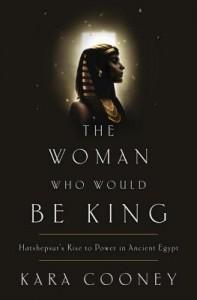Title: The Woman Who Would Be King
Author: Kara Cooney
ISBN: 978-0-307-95676-7
No. of Pages: 320
Genre: Nonfiction
Origins: Crown Publishing
Release Date: 14 October 2014
Bottom Line: A bit dry and lacking historical proof but still interesting
 Synopsis:
Synopsis:
“Hatshepsut—the daughter of a general who usurped Egypt’s throne and a mother with ties to the previous dynasty—was born into a privileged position in the royal household, and she was expected to bear the sons who would legitimize the reign of her father’s family. Her failure to produce a male heir was ultimately the twist of fate that paved the way for her improbable rule as a cross-dressing king. At just over twenty, Hatshepsut ascended to the rank of pharaoh in an elaborate coronation ceremony that set the tone for her spectacular reign as co-regent with Thutmose III, the infant king whose mother Hatshepsut out-maneuvered for a seat on the throne. Hatshepsut was a master strategist, cloaking her political power plays in the veil of piety and sexual reinvention. Just as women today face obstacles from a society that equates authority with masculinity, Hatshepsut shrewdly operated the levers of power to emerge as Egypt’s second female pharaoh.
Hatshepsut successfully negotiated a path from the royal nursery to the very pinnacle of authority, and her reign saw one of Ancient Egypt’s most prolific building periods. Scholars have long speculated as to why her monuments were destroyed within a few decades of her death, all but erasing evidence of her unprecedented rule. Constructing a rich narrative history using the artifacts that remain, noted Egyptologist Kara Cooney offers a remarkable interpretation of how Hatshepsut rapidly but methodically consolidated power—and why she fell from public favor just as quickly. The Woman Who Would Be King traces the unconventional life of an almost-forgotten pharaoh and explores our complicated reactions to women in power.”
Thoughts: From a subject matter perspective, The Woman Who Would Be King is fascinating. There are so few examples of women in power in the world, either historical or current, that any chance to look closer at those that existed is extremely important to understanding women’s changing position over the years. Ms. Cooney gives readers the close examination Hatshepsut deserves by providing readers with the rich backdrop that accompanied her rise to power.
Where the presentation is weak is in the distinct lack of concrete details. Not only is her legacy impaired from erasure by the Egyptian kings who followed her, but it suffers from everything she did to maintain her co-regency in a male-dominated society. Changing her portraits to those with masculine traits, using male pronouns, and other gender-masking tricks may have helped Egyptians accept her reign as king, but they made the picture for historians very indistinct. This means that most of the story Ms. Cooney has to present is conjecture. While she does an excellent job of stating what is purely hypothetical, the fact remains that almost all of it is a guess. There are so much speculation about all aspects of her life that readers will feel thoroughly underwhelmed by the multitude of “she might have” or “she could have” that exist throughout the book.
Ms. Cooney attempts to offset her hypotheses with as much fact as possible. This means that the other half of the book is detail upon detail of Egyptian life, politics, geography, and the like. While this is normally a very beneficial element to have in a biography, here it is all a bit too repetitive. The details never change as Hatshepsut rises to the height of her power, but readers still get the same explanations about the Egyptian belief systems and the connection between religious belief and royal power in each chapter. The first few times this occurs, readers can appreciate the attention to detail and the care Ms. Cooney takes to make sure readers understand the nuances of the society Hatshepsut ruled. However, after that, it becomes nothing but a nuisance and a distraction.
What The Woman Who Would Be King needs the most is imagery, something lacking in the advanced review copy but something one hopes the publisher rectifies in the finished version. Most of what historians know about Hatshepsut is because of her prolific building and statuary programs that still exist. There was simply too much for later kings to destroy in their entirety. Therefore, seeing pictures of her funerary temple, her obelisks, her statues, and other kingly imagery throughout Egypt would make Hatshepsut come to life more vividly and work to dispel the uneasy conjecture that exists within a majority of the book. One look at her funerary temple and readers instantly understand just how amazing Hatshepsut was as a leader.
Ultimately, Ms. Cooney does her best to present a fair and thorough narrative of Hatshepsut’s spectacular rise to king of Upper and Lower Egypt and one of the foremost leaders of the ancient world. That there is a dearth of details is not her fault, but the book does suffer because of that. There is simply too much guessing about her life and not enough concrete proof to appease discerning readers. Ms. Cooney attempts to compensate for the lack of evidence by adding as much Egyptian sociological, economic, and political history as possible, but the end result is a repetitive jumble of fact and guesswork that leaves readers wanting more. That Hatshepsut was an amazing woman is in no doubt, and readers will finish The Woman Who Would Be King recognizing that she is just another female leader who will forever remain a mystery because of the ongoing bias against such leadership.
